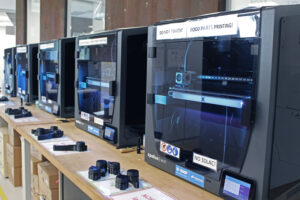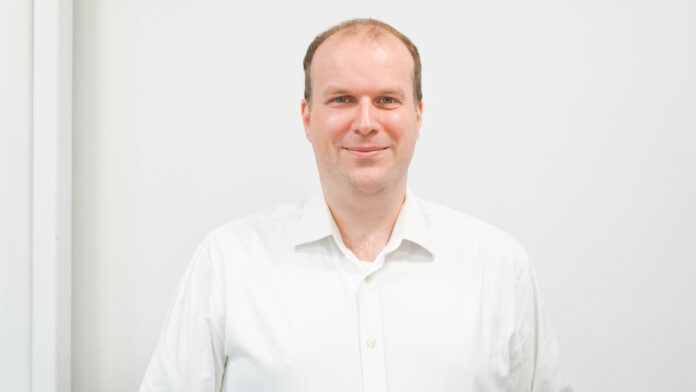Tell us a little about yourself, Dr. Siebert, and Replique.
After finalizing my PHD in material science at the Max Planck Institute for Polymer Research, I worked for several years at BASF as the head of the data-to-value team. In 2020, I co-founded Replique, and I am currently serving as its CEO. I’m passionate about new technologies, digitalization, and digital business models, especially in the B2B sector.
Replique provides the first fully encrypted 3D printing platform that makes spare part management and the production of small series more sustainable. Combining our digital inventory and a network of additive manufacturing professionals, we offer an end-to-end solution from qualification to production and shipment.
Give me some background information on Replique and how it got to where it is today.
Replique is the first fully encrypted digital inventory 3D printing/additive manufacturing (AM) platform that offers OEMs a secure and sustainable way of providing spare parts on demand, anytime, anywhere, to their customers.
We achieve this by combining our digital inventory platform with a global decentralized 3D printing network of qualified industrial AM professionals. Via this combination, we offer OEMs an end-to-end solution from design to manufacturing and part shipment, which can be fully integrated into B2B processes like ERP systems.
I think it’s relevant to mention the importance of our partnerships in progressing us to where we are today. Partnerships create mutual benefits and synergies that improve products for end-customers. In 3D printing this has proven to be a main enabler to scale industrial production. From our own perspective, close collaborations are essential to achieving the best solution. An ecosystem where service providers, material producers, and print farms worldwide are connected is how we build a better service.
Basically, Replique is an attractive solution for everybody producing small series and having to serve the aftermarket. As a consequence, our customer industries range from transportation, automotive, construction, pharma, and healthcare up to consumer goods and heavy machinery business. In fact, everybody who has a large inventory and is in need to get a reliable part supply with efficient total cost of ownership fits into our scope.
We’ve seen how large-scale manufacturers benefit from additive manufacturing in terms of increasing production without compromising quality or reliability of the products. But in what ways do small- and medium-scale manufacturers benefit from this technology?
Small- and medium-scale manufacturers benefit from the same things you mention, as well as both time- and cost-savings thanks to the fundamental agility and efficiency-driving capabilities of AM when compared to traditional manufacturing methods.
For SMEs, the value-proposition for AM makes perfect sense and enables the production of low-volume parts quickly and cost-effectively – particularly valuable when it comes to spare parts. This is mainly due to the fact that additional costs are eliminated. With an on-demand production model and the use of a digital inventory, you can minimize your storage and related costs. Moreover, you can reduce your transport costs and avoid administrative formalities with decentralized production. In the case of spare parts, you can further reduce the downtime costs of your customers, as parts are available on-demand in case of machine failures. Our customers are able to scale easily across country borders and have a large capacity and the most effective solution for every part on their fingertips. They do not need to spend a lot of time in onboarding and qualification of service bureaus. As we work with the best providers out there, we can always secure capacity as we bring relevant business to the service bureaus. Our customers profit from the expansive experience we have gathered from all industrial cases we have worked on.
 Where do you see additive manufacturing heading in the next 5, 10, 20 years or more as more companies and industries embrace IIoT technology and modern manufacturing practices?
Where do you see additive manufacturing heading in the next 5, 10, 20 years or more as more companies and industries embrace IIoT technology and modern manufacturing practices?
I think AM will continue to establish itself as the manufacturing technology of choice for companies large and small, and – as we are already witnessing – continue to take ground from existing manufacturing technologies that are inherently less agile, slower, and more costly insofar as total cost of ownership (TCO). I think the development of certain AM technologies will further drive this change; for example SAF technology that now enables the cost-effective production of much higher volumes of parts in the tens of thousands. Further, variable costs will decrease due to greater efficiency of printers. This will make additive manufacturing more attractive for use cases where it was previously too expensive.
And as it always has, advancements in materials development will continue to push application possibilities even further, as specific products are created to answer the ever-exacting needs of manufacturers.
The digital nature of AM makes it easy to integrate into software processes and get rid of paper heavy processes in contracting but also quality assurance processes. As AM printers are advanced IIoT devices, we for example provide a full digitalized data recording of every job executed. Data collected with IoT objects on a machine can for example be used to automatically order parts via a digital inventory platform to produce needed spare parts in case something breaks. Moreover, designs could be quickly improved and printed using collected data so you iterate designs much faster in the future, resulting in better customer offerings.
Are there any new products or services you’d like to highlight?
We continually improve the customer experience and add new features on our platform to provide our customers with an end-to-end solution. These are mainly quality assurance features and part screening services. We also are extending continuously partner integrations, as Replique is an API-first designed platform. So, anybody wishing or offering an AM solution can be integrated in the digital warehouse services and connected to the parts in there. Stay tuned for more information!
 What are some of the challenges associated with 3D printing or that you’ve experienced yourself in the industry or with customers?
What are some of the challenges associated with 3D printing or that you’ve experienced yourself in the industry or with customers?
The biggest challenge is to encourage customers to get started. Most of the companies see the advantages of 3D printing, but especially traditional industries are still very conservative and focus on old and existing processes.
Moreover, the translation from traditional into 3D printed parts can be challenging. There is not always a material that can be directly translated into 3D printing. Finding the right material and technology mix as well as redesigning a part for 3D printing can decide between a success and a failure of a 3D printing project. Once customers have recognized the benefits, customers accelerate in growth very quickly.
Can you give us a case study example wherein Replique helped a customer solve a problem they were experiencing via 3D printing products and/or services?
Replique is working with Alstom, a global leader in green and smart mobility, who uses our on-demand 3D printing platform to produce customized industrial-grade serial parts. By digitizing its supply chain, Alstom can leverage decentralized production of small batches on demand. This enables the company to respond even better to its customers’ needs. Replique reduces the complexity within the supply chain so that first series are not only produced faster, but also cost-competitively. The growth in parts in the inventory now happens at a very low to almost zero cost: with the digital warehouse, no ‘safe stock’ and warehousing of parts need to be done. As a consequence, further customization is easily accessible for Alstom now.
In your opinion, what makes Replique stand out in the industry from its competitors?
Coming from BASF, we combine knowhow of industrial processes with material expertise. Compared to other service providers, we not only offer access to 3D printing partners via our platform, but access to a whole 3D printing ecosystem. This includes a digital inventory, where manufacturers can safely store, manage, and order parts, consultation services, a worldwide AM expert, and production network, as well as the possible integration of e-commerce stores and other ERP systems. In the end, no customer needs to change business processes, as we integrate seamlessly. We have gathered vast experience in industrial manufacturing and speak their language. In addition, we have patented parts of the platform which secure the quality of the produced parts.
Which industries have you seen benefit the most from additive manufacturing?
The big sectors like aerospace, automotive, and medical have been deploying AM for many years, as has the manufacturing industry itself. However, we believe that any industry can benefit from the technology if utilized correctly. The problems 3D printing solves can occur in any industry, whether it’s consumer goods, agriculture, construction, mobility, or heavy machinery.
Some skeptics believe that 3D printing will never become an effective alternative to traditional manufacturing methods and will remain, at best, just a niche technology for special applications. What would you say to people who subscribe to this belief?
Even injection molding had skeptics 70 years back. At that time, using the technology to replace materials such as steel was not highly trusted. Furthermore, materials were scarce and infrastructure was missing in the beginning. There are many parallels with AM.
As always, it is not only about the technologies itself but also the right processes to utilize its strength. If you produce parts still in large batches and send them to central warehousing, you will only halfway benefit from the strength of AM. Going fully decentral in production is what will make AM interesting for any parts being produced in small quantities and we are certain that this long tail has a very large volume. Combining the supply chain and production in one integrated solution will make AM very attractive.
In addition, more and more parts will be designed for AM from the very beginning, making a redesign superficial. It is a little bit of a generation thing: universities start taking up AM in their curriculum, and for the actual generations of engineers, it will be another production method standing equally side-by-side with the ones we know.
Tell me about the role 3D printing plays in “bridge manufacturing” and supply chains that are susceptible to disruptions.
When supply chains are hit, people responsible for manufacturing and supply chain need a responsive and versatile solution that brings speed and adaptability so production can ramp up and down, switch gears or even shift to new locations. This has put the spotlight on 3D printing as it is the most viable option for bridge manufacturing, especially for industrial applications. Once a part is qualified and print parameters are set, there are no ramp up delays as it can simply be sent securely to a 3D print service bureau for fast, cost-effective production. And as I’ve said, that means exactly where the part is needed, when it is needed, and in the precise quantity needed – even just a lot size of one.
You can even use AM as a backup if you see a digital inventory as a kind of insurance, which enables you to switch quickly between providers in case of a supply shortage. Once set up, you are able to benefit from a large network with almost unlimited capacity. Just like the cloud has changed IT, this will change manufacturing towards more flexibility.
What’s on the horizon for Replique in the near and/or distant future?
Our goal is to become the leading and well-known partner for distributed manufacturing with our platform. Within the near future, we want to grow our company with the help of investors and spin-off from BASF to scale further. To realize our goal, we are continually extending our network of material and production partners, as well as adding more features to our digital platform.
Is there anything else you’d like to include that I haven’t asked?
As mentioned, I believe partnerships within 3D printing are paramount to provide the best possible solution. Within 3D printing, we now see the need for a more holistic collaboration. Standards have to be developed together, printer and post-processing systems should be able to work together; and collected production data could lead to improved printers and materials. Only with close collaborations and permanent exchange can those in the additive manufacturing sphere offer customers the best solutions. We closely work together with material but also printer and device manufacturers for the mutual benefit to address the market and provide customers the best possible solution. Our material partnership for example is a huge enabler and a real asset.
I also believe that data management and ownership will be a huge topic moving forward. This is why Replique carefully selects its production partners and takes the appropriate steps to ensure design data and other intellectual property is kept in the right hands. We enforce manufacturing parameters by encrypting the data, so parts can only be produced in the requested amount and material. By collecting manufacturing data and analyzing it, mistakes can be detected quickly, improving the process and ensuring all quality requirements are met.
Max Siebert is CEO & Co-Founder of BASF-owned, Replique, which offers an industrial 3D printing platform that enables OEMs to provide parts on-demand anytime and anywhere to their customers through a global, decentralized, and secured 3D printing network.




















